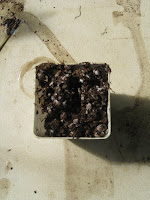 We all know that there's really nothing better than enjoying a fine wine along with a good meal. So as Terri reminded me, if you want to be truly sustainable, it's important to understand how to make your own alcohol. Plus as our economy continues to go crazy and prices rise, making your own wine is an extremely economical way to go. Terri explained to me that you can pretty much make wine out of any fruit you desire from mango to blackberry. However what typically drives Bob and Terri to embark on a new batch is an abundance of a particular fruit on the farm.
We all know that there's really nothing better than enjoying a fine wine along with a good meal. So as Terri reminded me, if you want to be truly sustainable, it's important to understand how to make your own alcohol. Plus as our economy continues to go crazy and prices rise, making your own wine is an extremely economical way to go. Terri explained to me that you can pretty much make wine out of any fruit you desire from mango to blackberry. However what typically drives Bob and Terri to embark on a new batch is an abundance of a particular fruit on the farm.At last (not that we had to wait long) a good overcast rainy day came our way and we
 decided it was the perfect time to make some wine. Our prime candidates for fruit were starfruit and bananas since they had been going off like nuts over the past few weeks, and they sell for such low prices at the market. I was soon to learn that wine making was easier than I imagined, however it is necessary to have all the right equipment before you get started.
decided it was the perfect time to make some wine. Our prime candidates for fruit were starfruit and bananas since they had been going off like nuts over the past few weeks, and they sell for such low prices at the market. I was soon to learn that wine making was easier than I imagined, however it is necessary to have all the right equipment before you get started.
The first step in our process was bottling the last batch Terri had made a few months back so we could re-use the gallon jugs. Terri and Bob save all their old glass beer, liquor and wine bottles to re-use in bottling their wine (not only is this economical, but it's also nice to have different size bottles since sometimes you only want to enjoy a glass or two of wine). The first step in t
 he process is sterilization of the bottles, then we get to work on siphoning the wine into the bottles careful not to get any of the nasty sediment in the batch. One of Terri's hot tips was to add a tablespoon of sugar to the bottle before you put the stopper in to add an extra effervescence and essentially a second mini fermentation for the wine once it's bottled. We bottled up Jackfruit, Mamey Sapote, Mountain Apple, Mead and Lilikoi wine- and the best part was sampling each and every one before we stuck them in the bottles and labeled them.
he process is sterilization of the bottles, then we get to work on siphoning the wine into the bottles careful not to get any of the nasty sediment in the batch. One of Terri's hot tips was to add a tablespoon of sugar to the bottle before you put the stopper in to add an extra effervescence and essentially a second mini fermentation for the wine once it's bottled. We bottled up Jackfruit, Mamey Sapote, Mountain Apple, Mead and Lilikoi wine- and the best part was sampling each and every one before we stuck them in the bottles and labeled them.
On to the fun part- making a new batch of wines! We made two gallons of starfruit, one gallon of banana and 1 gallon of lemon wine. I've listed the steps we followed in their simplest form, as well as included a mini version of an article Terri wrote last year on how to make your own starfruit wine.
1. Prepare the wine making produce by cutting up larger fruit, busting skins on smaller fruit, and removing any pits or seeds. It is also important to understand that you can over-process the produce- so don't mash or blend fruit with blenders, just use your hands!

2. Siphon juice and mashed fruit into gallon jugs, then add approximately 4 quarts of water and 1 quart of organic honey and shake it all up until honey is dissolved. Activate yeast (Terri likes to use champagne yeast to add an extra effervesence to h
 er wine) in warm water, then add an equal portion to each jug.
er wine) in warm water, then add an equal portion to each jug.3. Immediately cover jugs with airtight stoppers and wait! Allow this mixture (must) to ferment for 5 to 7 days. You should start to see some foaming activity within 24 hours of adding the yeast. Typically, 70% of the fermentation activity will occur during this 5 to 7 day period.
4. After 5 to 7 days remove the pulp from the jug and discard. Siphon the wine into a secondary jug in a careful manner, so as to leave the sediment behind. Bottle immediately, or leave to continue firmentation for as long as you like.

Not only was it awesome to learn the entire process, but the best part was sampling a mead Terri had made 2 years ago (and aged) to accompany our pasta dinner that evening- AMAZING. I would highly recommend trying to make some wine of your own, and I plan on making some more for myself as soon as I return home!

















































